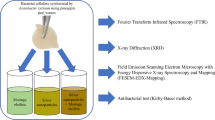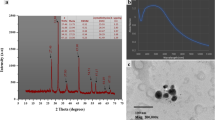Abstract
Antimicrobial properties of oxidized cellulose and its salts in linters (-L) and microsphere (-M) form (OKCEL® H-L, OKCEL® Zn-M, OKCEL® ZnNa-L, OKCEL® ZnNa-M and OKCEL® Ag-L) were tested by a dilution method against a spectrum of microbial strains: Escherichia coli, Pseudomonas aeruginosa, Staphylococcus epidermidis, Bacillus licheniformis, Aspergillus niger, Penicillium chrysogenum, Rhizopus oryzae, Scopulariopsis brevicaulis, Candida albicans and Candida tropicalis. OKCEL® Ag-L exhibited antimicrobial activity in the range 0.1–3.5% w/v against all the bacteria and fungi involved in this study. Strong inhibition by OKCEL® ZnNa-M was observed for Staphylococcus epidermidis, Bacillus licheniformis, Rhizopus oryzae, Candida albicans and Candida tropicalis in the range 0.5–2.0% w/v. Antimicrobial effects of oxidized cellulose and its salts in textile form were investigated by a diffusion and dilution method against the spectrum of above-cited microbial strains extended by Clostridium perfringens. Generally, OKCEL® Ag-T, OKCEL® Zn-T and OKCEL® H-T showed high antimicrobial activity against populations of Pseudomonas aeruginosa, Bacillus licheniformis and Staphylococcus epidermidis. OKCEL® Zn-T was the only sample suppressing the growth of species.


Similar content being viewed by others
References
Abaev IK, Kaputskii VE, Adarchenko AA, Sobeshchukh OP (1986) Mechanism of the antibacterial action of monocarboxycellulose and other ion-exchange derivatives of cellulose. Antibiot Med Biotechnol 31:624–628
Atmaca S, Gül K, Çiçek R (1998) The effect of zinc on microbial growth. Tr J Med Sci 28:595–597
Cason JS, Jackson DM, Lowbury EJ, Ricketts CR (1966) Antiseptic and aseptic prophylaxis for burns: use of silver nitrate and of isolators. Br Med J 2:1288–1294
Ferrari MJ, Turnidge JD (2003) Antibacterial agents and suspectibility test methods. ASM Press, Washington, pp 1037–1196
Ip M, Lui SL, Poon VK, Lung I, Burd A (2006) Antimicrobial activities of silver dressings: an in vitro comparison. J Med Microbiol 55:59–63
Kumar V (2004) Regenerated cellulose and oxidized cellulose membranes as potential biodegradable platforms for drug delivery and tissue engineering. University of Iowa Research Foundation (Iowa City, IA), United States Patent no. 6.800.753. 5. 10. 2004
Lansdown AB (2002) The role of silver. J Eur Tissue Rep Soc 9:108–111
Li XZ, Nikaido H, Williams KE (1997) Silver-resistant mutants of Escherichia coli display active efflux of Ag+ and are deficient in porins. J Bacteriol 179:6127–6132
Maillard JY, Denyer SP (2006) Focus on silver. EWMA J 6:5–7
Percival SL, Bowler PG, Russell D (2005) Bacterial resistance to silver in wound care. J Hosp Infect 60:1–7
Pernet M (1983) Antibacterial effect of oxidized regenerated cellulose. Ann Chir 37:700–701
Russell AD, Hugo WB (1994) Antimicrobial activity and action of silver. Prog Med Chem 31:351–370
Simonetti N, Simonetti G, Bougnol F, Scalzo M (1992) Electrochemical Ag+ for preservative use. Appl Environ Microbiol 58:3834–3836
Södeberg TA, Sunze B, Holm S, Elmro T, Hallmans G, Sjöberg S (1990) Antibacterial effect of zinc oxide in vitro. Scand J Plast Reconstr Hand Surg 24:193–197
Spangler D, Rothenburger S, Nguyen K, Jampani H, Weiss S, Bhende S (2003) In vitro antimicrobial activity of oxidized regenerated cellulose against antibiotic-resistant microorganisms. Surg Infect (Larchmt) 4:255–262
Sugarman B (1983) Zinc and infection. Rev Infect Dis 5:138–147
Valouchová V, Vytrasova J (2005) Antimicrobial activity of impregnated textiles. Diploma thesis, University of Pardubice, Pardubice
Wells TN, Scully P, Paravicini G, Proudfoot AE, Payton MA (1995) Mechanisms of irreversible inactivation of phosphomannose isomerases by silver ions and flamazine. Biochemistry 34:7896–7903
Woodward RL (1963) Review of the effectiveness of silver. J Am Water Works Assoc 55:881–886
Acknowledgments
The work was supported by Ministry of Industry and Trade of the Czech Republic (project no. FT-TA2/011) and by Czech Science Foundation (project no. 203/08/1536).
Author information
Authors and Affiliations
Corresponding author
Rights and permissions
About this article
Cite this article
Vytrasova, J., Tylsova, A., Brozkova, I. et al. Antimicrobial effect of oxidized cellulose salts. J Ind Microbiol Biotechnol 35, 1247–1252 (2008). https://doi.org/10.1007/s10295-008-0421-y
Received:
Accepted:
Published:
Issue Date:
DOI: https://doi.org/10.1007/s10295-008-0421-y




